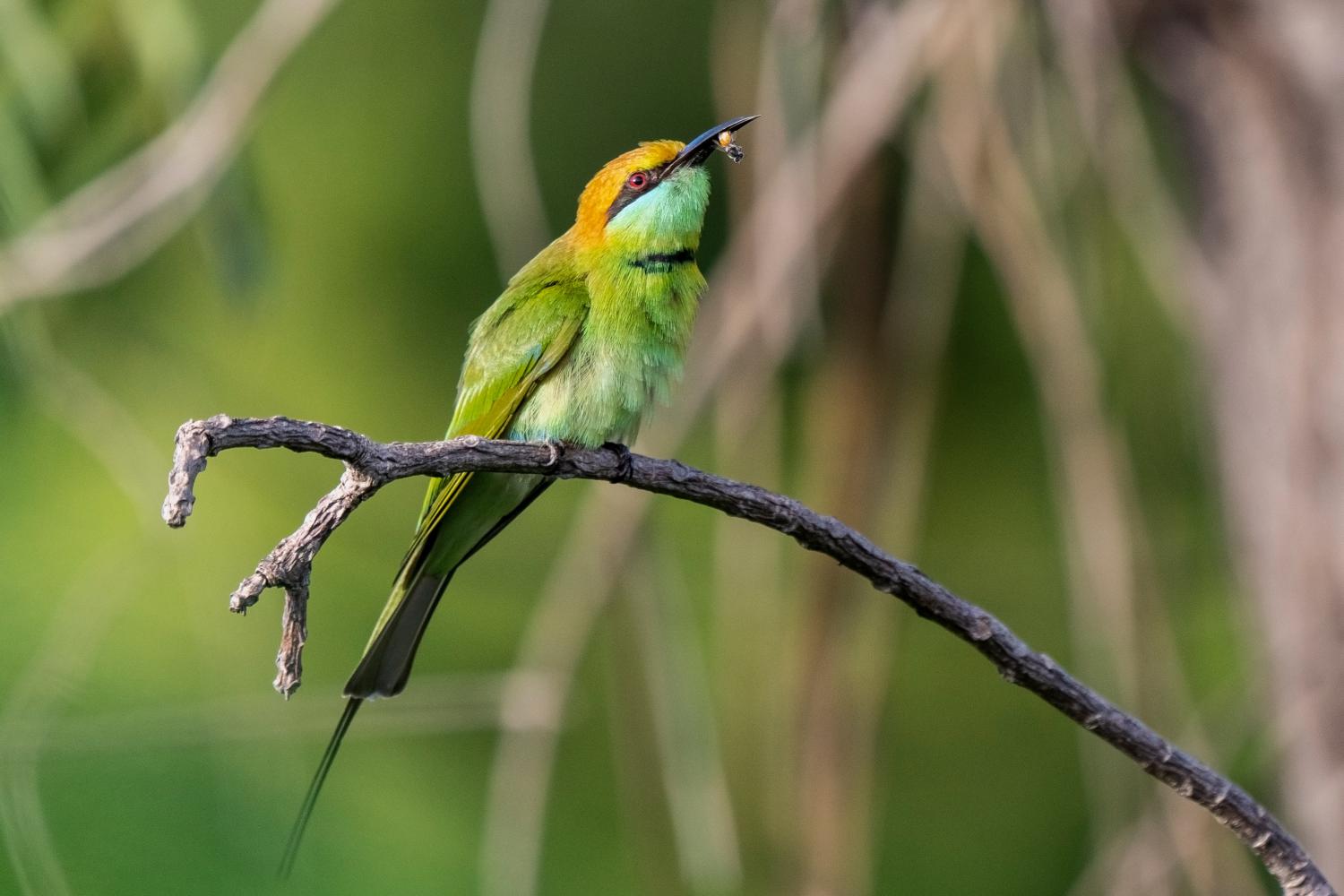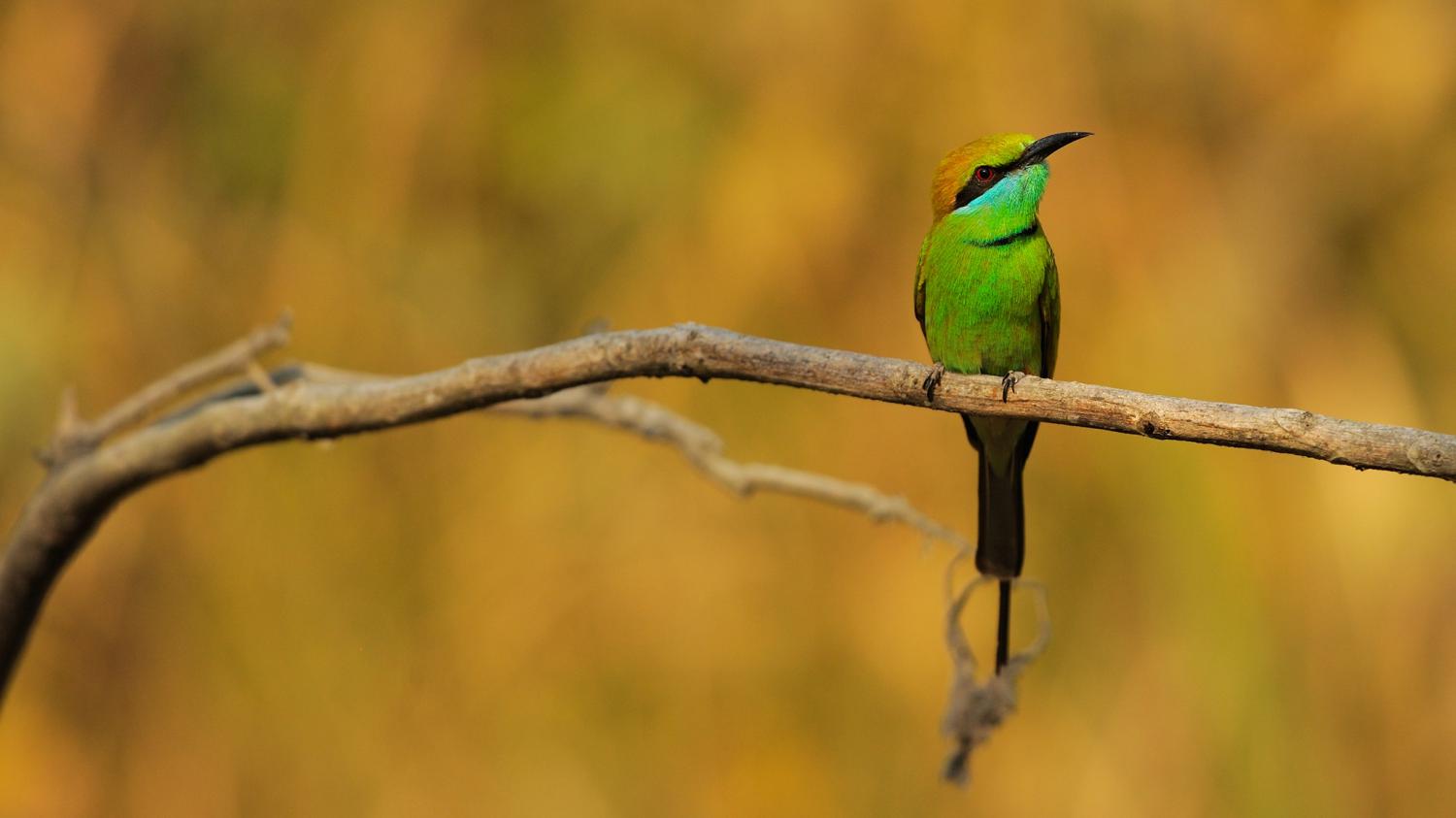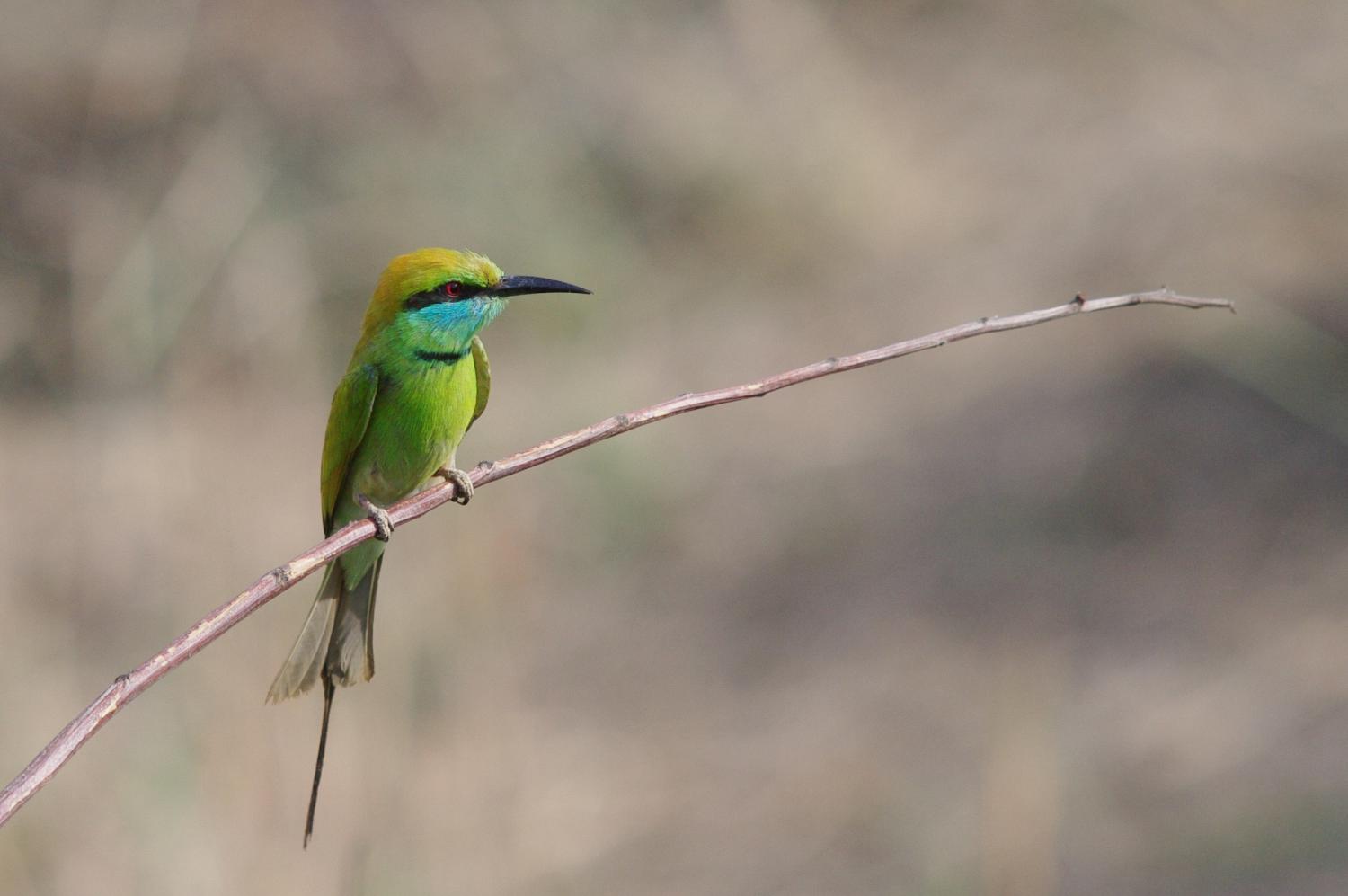Species of Thailand
Green bee-eater
Merops orientalis
John Aubrey Clarendon Latham, 1802
In Thai: นกจาบคาเล็ก
The green bee-eater (Merops orientalis), also known as little green bee-eater, is a near passerine bird in the bee-eater family. It is resident but prone to seasonal movements and is found widely distributed across sub-Saharan Africa from Senegal and the Gambia to Ethiopia, the Nile valley, western Arabia and Asia through India to Vietnam. They are mainly insect eaters and they are found in grassland, thin scrub and forest often quite far from water. Several regional plumage variations are known and several subspecies have been named.
Taxonomy and systematics
The green bee-eater was first described by the English ornithologist John Latham in 1801 using its current binomial name. Several populations have been designated as subspecies:
- M. o. viridissimus is found from Senegal to northern Ethiopia (has more green on the throat, crown and nape with long streamers)
- M. o. cleopatra from the Nile Valley to northern Sudan
- M. o. flavoviridis from northern Chad to Sudan
- M. o. muscatensis on the Arabian plateau (more yellowish green with narrow gorget on throat)
- M. o. cyanophrys found in Israel and the Arabian region (includes meccanus)
- M. o. beludschicus(=M. o. biludschicus) Iran to Pakistan (paler colours with a blue throat)
- M. o. orientalis in India and Sri Lanka (has head and neck tinged with rufous).
- M. o. ferrugeiceps (=birmanus) in northeastern India, Myanmar, Thailand and Vietnam (has rufous crown, mane and mantle). I
- M. o. ceylonicus in Sri Lanka has the nape and hindneck with more pronounced golden brown sheen often included within the nominate race
A study of species within the genus Merops based on plumage characteristics found that most of the subspecies of M. o. orientalis grouping together with the most similar species being Merops leschenaulti and subspecies M. o. ferrugeiceps appeared closer to that group.
Description
Like other bee-eaters, this species is a richly coloured, slender bird. It is about 9 inches (16–18 cm) long with about 2 inches made up by the elongated central tail-feathers. The sexes are not visually distinguishable. The entire plumage is bright green and tinged with blue especially on the chin and throat. The crown and upper back are tinged with golden rufous. The flight feathers are rufous washed with green and tipped with blackish. A fine black line runs in front of and behind the eye. The iris is crimson and the bill is black while the legs are dark grey. The feet are weak with the three toes joined at the base. Southeast Asian birds have rufous crown and face, and green underparts, whereas Arabian beludschicus has a green crown, blue face and bluish underparts. The wings are green and the beak is black. The elongated tail feathers are absent in juveniles. Sexes are alike.
The calls is a nasal trill tree-tree-tree-tree, usually given in flight.
Leucistic individuals have been noted.
Distribution and habitat
This is an abundant and fairly tame bird, familiar throughout its range. It is a bird which breeds in open country with bushes. In Africa and Arabia it is found in arid areas, but is more diverse in its habitats further east. This species often hunts from low perches, maybe only a metre or less high. It readily makes use of fence wires and electric wires. Unlike some other bee-eaters, they can be found well away from water.
They are mostly seen in the plains but can sometimes be found up to 5000 or 6000 feet in the Himalayas. They are resident in the lowlands of South Asia but some populations move seasonally but the patterns are not clear, moving away to drier regions in the rainy season and to warmer regions in winter. In parts of Pakistan, they are summer visitors.
Behaviour and ecology
Like other species in the genus, bee-eaters predominantly eat insects, especially bees, wasps and ants, which are caught in the air by sorties from an open perch. Before swallowing prey, a bee-eater removes stings and breaks the exoskeleton of the prey by repeatedly thrashing it on the perch. Migration is not known but they make seasonal movements in response to rainfall. These birds are somewhat sluggish in the mornings and may be found huddled next to each other on wires sometimes with their bills tucked in their backs well after sunrise. They sand-bathe more frequently than other bee-eater species and will sometimes bathe in water by dipping into water in flight. They are usually seen in small groups and often roost communally in large numbers (200-300). The birds move excitedly at the roost site and call loudly, often explosively dispersing before settling back to the roost tree.
The little green bee-eater is also becoming common in urban and sub-urban neighborhoods, and has been observed perching on television antennae, only to launch into a brief, zig-zag flight formation to catch an insect, then return to the same perch and consume the meal. This behaviour is generally observed between the hours of 7:00 and 8:00am, and after 4:00pm.
The breeding season is from March to June. Unlike many bee-eaters, these are often solitary nesters, making a tunnel in a sandy bank. The breeding pairs are often joined by helpers. They nest in hollows in vertical mud banks. The nest tunnel that they construct can run as much as 5 feet long and the 3-5 eggs are laid on the bare ground in the cavity at the end of the tunnel. The eggs are very spherical and glossy white. Clutch size varies with rainfall and insect food density. Both sexes incubate. The eggs hatch asynchronously with an incubation period of about 14 days and the chicks grow fledge in 3 to 4 weeks and in the fledging stage show a reduction in body weight.from Sde Boker, Israel|leftA study suggested that green bee-eaters may be capable of interpreting the behaviour of human observers. They showed an ability to predict whether a human at a particular location would be capable of spotting the nest entrance and then behaved appropriately to avoid giving away the nest location. The ability to look at a situation from another's point of view was previously believed to be possessed only by primates.
Riverside habitats were found to support high populations in southern India (157 birds per square kilometre) dropping off too 101 per km² in agricultural areas and 43-58 per square km near human habitations.
They feed on flying insects and can sometimes be nuisance to bee-keepers. The preferred prey was mostly beetles followed by hymenopterans. Orthopterans appear to be avoided. They are sometimes known to take crabs. Like most other birds they regurgitate the hard parts of their prey as pellets.
An endoparasitic nematode (Torquatoides balanocephala) sometimes infects their gizzard. A protozoal parasite in their blood, Haemoproteus manwelli, has been described from India.
This article uses material from Wikipedia released under the Creative Commons Attribution-Share-Alike Licence 3.0. Eventual photos shown in this page may or may not be from Wikipedia, please see the license details for photos in photo by-lines.
Category / Seasonal Status
BCST Category: Recorded in an apparently wild state within the last 50 years
BCST Seasonal status: Resident or presumed resident
Scientific classification
- Kingdom
- Animalia
- Phylum
- Chordata
- Class
- Aves
- Order
- Coraciiformes
- Family
- Meropidae
- Genus
- Merops
- Species
- Merops orientalis
Common names
- Thai: นกจาบคาเล็ก
Subspecies
Merops orientalis beludschicus, Oscar Rudolph Neumann, 1910
Merops orientalis ceylonicus, Hugh Whistler, 1944
Merops orientalis cleopatra, Michael John Nicoll, 1910
Merops orientalis cyanophrys, Jean Louis Cabanis & Ferdinand Heine, 1860
Merops orientalis ferrugeiceps, John Anderson, 1879
Merops orientalis flavoviridis, Günther Niethammer, 1955
Merops orientalis muscatensis, Richard Bowdler Sharpe, 1886
Merops orientalis orientalis, John Aubrey Clarendon Latham, 1802
Merops orientalis viridissimus, William John Swainson, 1837
Synonyms
- Merops viridis, Oscar Rudolph Neumann (1910)
Conservation status

Least Concern (IUCN3.1)
Photos
Please help us review the bird photos if wrong ones are used. We can be reached via our contact us page.
Range Map

- Amphawa District, Samut Songkhram
- Ban Chang District, Rayong
- Ban Hong Non-Hunting Area
- Ban Laem District, Phetchaburi
- Ban Lat District, Phetchaburi
- Ban Phai District, Khon Kaen
- Ban Sang District, Prachinburi
- Bang Ban District, Phra Nakhon Si Ayutthaya
- Bang Pa In District, Phra Nakhon Si Ayutthaya
- Bang Phra Non-Hunting Area
- Bang Pu Recreation Centre
- Bangkok Province
- Borabue District, Maha Sarakham
- Bueng Boraped Non-Hunting Area
- Buntharik District, Ubon Ratchathani
- Chae Hom District, Lampang
- Chaloem Phra Kiat District, Saraburi
- Chatturat District, Chaiyaphum
- Chiang Dao District, Chiang Mai
- Chiang Dao Wildlife Sanctuary
- Chiang Khong District, Chiang Rai
- Chiang Saen District, Chiang Rai
- Chum Ta Bong District, Nakhon Sawan
- Dan Chang District, Suphan Buri
- Doi Inthanon National Park
- Doi Khun Tan National Park
- Doi Lang
- Doi Lo District, Chiang Mai
- Doi Pha Hom Pok National Park
- Doi Saket District, Chiang Mai
- Doi Suthep - Pui National Park
- Doi Tao District, Chiang Mai
- Don Chedi District, Suphan Buri
- Erawan National Park
- Fang District, Chiang Mai
- Hang Chat District, Lampang
- Hat Wanakon National Park
- Hua Hin District, Prachuap Khiri Khan
- Huai Chorakhe Mak Reservoir Non-Hunting Area
- Huai Kha Khaeng Wildlife Sanctuary
- Huai Krachao District, Kanchanaburi
- Huai Sala Wildlife Sanctuary
- Huai Talat Reservoir Non-Hunting Area
- In Buri District, Sing Buri
- Kabin Buri District, Prachinburi
- Kaeng Khoi District, Saraburi
- Kaeng Khro District, Chaiyaphum
- Kaeng Krachan District, Phetchaburi
- Kaeng Krachan National Park
- Kaeng Tana National Park
- Kamphaeng Saen District, Nakhon Pathom
- Kanthararom District, Sisaket
- Kantharawichai District, Maha Sarakham
- Khao Ang Rue Nai Wildlife Sanctuary
- Khao Khiao - Khao Chomphu Wildlife Sanctuary
- Khao Kradong Forest Park
- Khao Nang Phanthurat Forest Park
- Khao Sam Roi Yot National Park
- Khao Sanam Prieng Wildlife Sanctuary
- Khao Yai National Park
- Khao Yoi District, Phetchaburi
- Khemarat District, Ubon Ratchathani
- Khok Sung District, Sa Kaeo
- Khun Tan District, Chiang Rai
- Khung Kraben Non-Hunting Area
- Klaeng District, Rayong
- Ko Sichang District, Chonburi
- Kui Buri National Park
- Kumphawapi District, Udon Thani
- Kut Thing Non-Hunting Area
- Laem Pak Bia
- Li District, Lamphun
- Mae Ai District, Chiang Mai
- Mae Chan District, Chiang Rai
- Mae Mo District, Lampang
- Mae Ping National Park
- Mae Poen District, Nakhon Sawan
- Mae Rim District, Chiang Mai
- Mae Sot District, Tak
- Mae Taeng District, Chiang Mai
- Mae Tha, Lampang District, Lampang
- Mae Wong National Park
- Mancha Khiri District, Khon Kaen
- Mueang Buriram District, Buriram
- Mueang Chaiyaphum District, Chaiyaphum
- Mueang Chiang Mai District, Chiang Mai
- Mueang Chiang Rai District, Chiang Rai
- Mueang Chonburi District, Chonburi
- Mueang Kalasin District, Kalasin
- Mueang Kanchanaburi District, Kanchanaburi
- Mueang Khon Kaen District, Khon Kaen
- Mueang Lampang District, Lampang
- Mueang Lamphun District, Lamphun
- Mueang Lopburi District, Lopburi
- Mueang Maha Sarakham District, Maha Sarakham
- Mueang Nakhon Nayok District, Nakhon Nayok
- Mueang Nakhon Pathom District, Nakhon Pathom
- Mueang Nakhon Ratchasima District, Nakhon Ratchasima
- Mueang Nakhon Sawan District, Nakhon Sawan
- Mueang Nong Khai District, Nong Khai
- Mueang Nonthaburi District, Nonthaburi
- Mueang Phetchabun District, Phetchabun
- Mueang Phetchaburi District, Phetchaburi
- Mueang Phichit District, Phichit
- Mueang Phitsanulok District, Phitsanulok
- Mueang Prachuap Khiri Khan District, Prachuap Khiri Khan
- Mueang Ratchaburi District, Ratchaburi
- Mueang Rayong District, Rayong
- Mueang Sa Kaeo District, Sa Kaeo
- Mueang Samut Sakhon District, Samut Sakhon
- Mueang Sisaket District, Sisaket
- Mueang Sukhothai District, Sukhothai
- Mueang Suphanburi District, Suphan Buri
- Mueang Surin District, Surin
- Mueang Tak District, Tak
- Mueang Udon Thani District, Udon Thani
- Mueang Uttaradit District, Uttaradit
- Na Chaluai District, Ubon Ratchathani
- Nam Nao National Park
- Nam Yuen District, Ubon Ratchathani
- Non Din Daeng District, Buriram
- Non Sang District, Nong Bua Lamphu
- Non Thai District, Nakhon Ratchasima
- Nong Bong Khai Non-Hunting Area
- Nong Prue District, Kanchanaburi
- Nong Song Hong District, Khon Kaen
- Nong Waeng Non-Hunting Area
- Nong Ya Plong District, Phetchaburi
- Pa Sak Chonlasit Dam Non-Hunting Area
- Pa Sang District, Lamphun
- Pae Mueang Pee Forest Park
- Pai District, Mae Hong Son
- Pak Chong District, Nakhon Ratchasima
- Pak Phli District, Nakhon Nayok
- Pak Thale
- Pak Tho District, Ratchaburi
- Pak Thong Chai District, Nakhon Ratchasima
- Pang Sida National Park
- Pha Daeng National Park
- Pha Taem National Park
- Phaisali District, Nakhon Sawan
- Phanat Nikhom District, Chonburi
- Phatthana Nikhom District, Lopburi
- Phimai District, Nakhon Ratchasima
- Phu Langka National Park
- Phu Soi Dao National Park
- Phu Wiang National Park
- Phutthamonthon District, Nakhon Pathom
- Pran Buri District, Prachuap Khiri Khan
- Pran Buri Forest Park
- Ratchasan District, Chachoengsao
- Rattanaburi District, Surin
- Sai Yok District, Kanchanaburi
- Sai Yok National Park
- Sakaerat Environmental Research Station
- Salawin National Park
- Samae San Island
- Samut Prakan Province
- San Sai District, Chiang Mai
- Sanam Bin Reservoir Non-Hunting Area
- Sanam Chai Khet District, Chachoengsao
- Sattahip District, Chonburi
- Si Maha Phot District, Prachinburi
- Si Racha District, Chonburi
- Si Satchanalai District, Sukhothai
- Si Thep District, Phetchabun
- Sop Prap District, Lampang
- Sri Nakarin Dam National Park
- Sung Noen District, Nakhon Ratchasima
- Ta Phraya National Park
- Taksin Maharat National Park
- Taphan Hin District, Phichit
- Tha Takiap District, Chachoengsao
- Tha Yang District, Phetchaburi
- Thao Kosa Forest Park
- Thap Lan National Park
- Thawat Buri District, Roi Et
- Wang Chan District, Rayong
- Wapi Pathum District, Maha Sarakham
- Wat Phai Lom & Wat Ampu Wararam Non-Hunting Area
- Wat Tham Erawan Non-Hunting Area
- Watthana Nakhon District, Sa Kaeo
- Wiang Chai District, Chiang Rai
- Wiang Kaen District, Chiang Rai
- Yang Talat District, Kalasin





